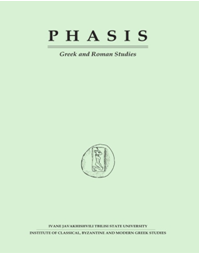Der Inbegriff des Kinetischen im Menschen bei Gregor von Nyssa
DOI:
https://doi.org/10.48614/phasis.18.2015.66-89Abstract
This paper explores the notion of movement as expressed by the generic term kinesis and its grammatical and conceptual derivatives, which regularly occur in Gregory of Nyssa’s anthropology. Despite some investigations into the issue within the framework of careful research on Gregory’s thought, a more systematic examination of the concept in his anthropological doctrine remains a considerable desideratum. I would like to contribute a general sketch of such analysis. The doctrine as presented by Nyssen implies numerous elements of syncretic doctrine about man’s nature that were widely accepted in Late Antiquity. Nevertheless, through three structured topics for this research – 1) The cosmic motion in its relation to man; 2) The motion of body and soul in man; and 3) Spiritual ascent as a type of motion – I argue that the concept of motion in Nyssen’s anthropology has an authentic character as he rethinks the inherited philosophical ideas according to the biblical model of the relation between universe, man and God. The concept of man as the central creation and image of God results in Nyssen’s shifting the sensible universe with its rotation as an ideal form of motion in Greek philosophy from the central position it had to the background, replacing it by the phenomenon of man. Although the sensible cosmos ruled by the wisdom of God remains a paradigm for the ideal constellation of mind, affects and body in man, the highest type of motion – as St. Gregory recognizes in line with Platonic metaphysics – is spiritual motion. The distinctive feature fundamentally different from the Platonic stance is that St. Gregory (a) highlights the motif of the mystical movement to God, independent from and opposed to the cosmic cyclical harmony, and (b) interprets this spiritual process as an infinite qualitative ascent to the infinite God. Expressed in geometrical terms the concept in Nyssen’s epistemology can be traced by his giving precedence to straight line vertical motion before cyclical motion.Downloads
Published
2015-02-16
Issue
Section
Articles
License
Copyright (c) 2015 PHASIS

This work is licensed under a Creative Commons Attribution-NonCommercial 4.0 International License.


